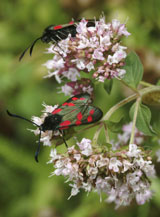Chalk grassland
You need Adobe Flash Player, or an HTML5 enabled web browser, and JavaScript enabled to watch this video.
Visit the Adobe website to download the latest Adobe Flash Player
Chalk grassland is a widespread habitat on the north and south downs of southern England. It is rich in colourful flowering plants and insect life.
In the video above, Museum botanist Fred Rumsey introduces us to the beautiful and rare pasque flower, Pulsatilla vulgaris, which grows in Britain's chalk grasslands. The flower, which usually blooms in time for Easter each year, has shrunk in population and now only occurs in 19 sites across England.
History
Traditionally, chalk grasslands have been managed by sheep grazing. You can see track-ways eroded into the hillsides that provide evidence of the routes taken by animals over many decades.
Lowland chalk grassland is confined to the North and South Downs in southern England, from Kent through to Wiltshire and Dorset, with most remaining areas found on escarpments and dry valley slopes.
Features
The harsh environmental conditions found on chalk include summer heat and drought, winter frosts and poor soil nutrient status. Together with regular grazing, these prevent any individual species from reaching its full potential. The result is a very diverse habitat where no single species can out-compete the others.
Habitat for wildlife
Ancient chalk grassland, which has not been improved by the addition of artificial fertiliser, can be incredibly rich in plant life, supporting up to 40 species per square metre. Plants include cowslip (Primula verris), kidney vetch (Anthyllis vulneraria), quaking grass (Briza media) and sheep's fescue (Festuca rubra) as well as many species of orchid. These include fragrant orchid (Gymnadenia conopsea), bee orchid (Ophrys apifera) and the pink pyramidal orchid (Anacamptis pyramidalis).
Chalk grasslands are rich in insect life, including a number of butterflies and moths associated solely with this habitat. A walk in summer will see the grassland alive with the iridescent blue of an Adonis blue and the brown and orange of the gatekeeper butterflies. The sound of a number of different cricket and grasshopper species can be heard during the summer months.
Habitat Loss
As with meadows and traditional pastures, the extent and quality of chalk grassland has declined since the 1940s as more intensive methods of agriculture have been used.
Large areas of chalk grassland have also been lost because of urban development and extensive road building, especially in the south east.
There are no precise figures but surveys of a sample of chalk grasslands showed a loss of 20% between 1966 and 1980.
Chalk grassland has also suffered from lack of grazing which alters the composition of the grassland and can allow scrub to take over. Over-grazing can also be a problem.
Managing chalk grassland
Traditionally, chalk grasslands have been managed by sheep grazing. Sheep are the ideal animals to manage chalk grasslands since they graze the sward between the flower stalks leaving the nectar sources for the insects and the seeds for future years.
Some of the remaining chalk grassland sites are now under conservation management. Scrub has been cut back and grazing management restored.
Chalk grassland in the Museum's Wildlife Garden

6-spot burnett moths in the Wildlife Garden
The chalk mound within the Wildlife Garden is a good example of natural chalk grassland and is of interest from spring through to late autumn. The Museum's sheep may be seen grazing in late summer and early autumn. Cowslips grow throughout the grass in spring followed by:
- oxeye daisies (Leucantheum vulgare)
- bird's-foot trefoil (Lotus corniculatus)
- common spotted orchid (Dactylorhiza fuchsii)
- wild marjoram (Origanum vulgare)
- salad burnet (Sanguisorba minor ssp. minor)
Finally, late summer colour is provided by:
- small scabious (Scabiosa columbaria)
- knapweed (Centaurea nigra)
Together these flowers form a colourful display, from the yellow of the cowslips to the pale lilac scabious and bright purple knapweed.
Chalk grassland in your garden
Many chalk grassland plants only thrive in the harsh soil conditions offered by chalk but others can be grown amongst garden flowers. These provide nectar for insects and seeds for birds in winter. Small scabious and common knapweed look attractive in flower borders, while cowslips will transform an area of your lawn in March and April. Leave an area of uncut grasses throughout the year for frogs, grasshoppers or other insects.
